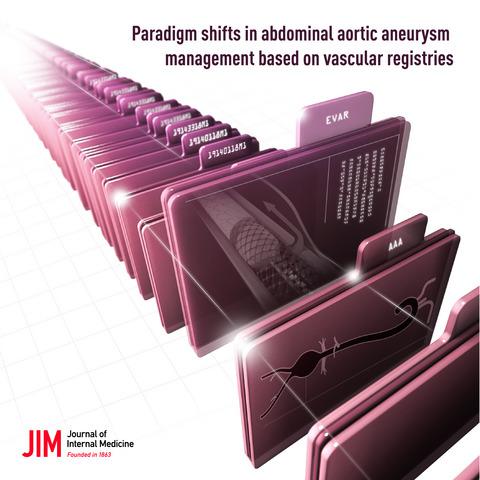当前位置:
X-MOL 学术
›
J. Intern. Med.
›
论文详情
Our official English website, www.x-mol.net, welcomes your
feedback! (Note: you will need to create a separate account there.)
Paradigm shifts in abdominal aortic aneurysm management based on vascular registries.
Journal of Internal Medicine ( IF 9.0 ) Pub Date : 2020-03-02 , DOI: 10.1111/joim.13051 L de Guerre 1, 2 , M Venermo 3 , K Mani 4 , A Wanhainen 4 , M Schermerhorn 1
Journal of Internal Medicine ( IF 9.0 ) Pub Date : 2020-03-02 , DOI: 10.1111/joim.13051 L de Guerre 1, 2 , M Venermo 3 , K Mani 4 , A Wanhainen 4 , M Schermerhorn 1
Affiliation

|
Abdominal aortic aneurysm (AAA) is a relatively common and potentially fatal disease. The management of AAA has undergone extensive changes in the last two decades. High quality vascular surgical registries were established early and have been found to be instrumental in the evaluation and monitoring of these changes, most notably the wide implementation of minimally invasive endovascular surgical technology. Trends over the years showed the increased use of endovascular aneurysm repair (EVAR) over open repair, the decreasing perioperative adverse outcomes and the early survival advantage of EVAR. Also, data from the early EVAR years changed the views on endoleak management and showed the importance of tracking the implementation of new techniques. Registry data complemented the randomized trials performed in aortic surgery by showing the high rate of laparotomy‐related reinterventions after open repair. Also, they are an essential tool for the understanding of outcomes in a broad patient population, evaluating the generalizability of findings from randomized trials and analysing changes over time. By using large‐scale data over longer periods of time, the importance of centralization of care to high‐volume centres was shown, particularly for open repair. Additionally, large‐scale databases can offer an opportunity to assess practice and outcomes in patient subgroups (e.g. treatment of AAA in women and the elderly) as well as in rare aortic pathologies. In this review article, we point out the most important paradigm shifts in AAA management based on vascular registry data.
中文翻译:

腹主动脉瘤管理基于血管登记的范式转移。
腹主动脉瘤(AAA)是一种相对常见且可能致命的疾病。在过去的二十年中,AAA的管理发生了巨大的变化。高质量的血管外科注册系统早已建立,并已被发现可用于评估和监测这些变化,尤其是微创血管内外科技术的广泛实施。多年来的趋势表明,血管内动脉瘤修补术(EVAR)的使用率高于开放性修补术,围手术期不良结局减少,EVAR的早期生存优势。此外,EVAR早期的数据改变了对内漏管理的看法,并显示了跟踪新技术实施的重要性。注册表数据通过显示开放修复后开腹手术相关的高干预率,对主动脉手术中进行的随机试验进行了补充。此外,它们还是了解广泛患者结局,评估随机试验结果的普遍性以及分析随时间变化的必要工具。通过长时间使用大规模数据,显示了将护理集中到高容量中心的重要性,特别是对于开放式维修。此外,大型数据库还可以提供机会来评估患者亚组的实践和结果(例如妇女和老年人的AAA治疗)以及罕见的主动脉病变。在这篇综述文章中,我们指出了基于血管注册数据的AAA管理中最重要的范例转变。
更新日期:2020-03-02
中文翻译:

腹主动脉瘤管理基于血管登记的范式转移。
腹主动脉瘤(AAA)是一种相对常见且可能致命的疾病。在过去的二十年中,AAA的管理发生了巨大的变化。高质量的血管外科注册系统早已建立,并已被发现可用于评估和监测这些变化,尤其是微创血管内外科技术的广泛实施。多年来的趋势表明,血管内动脉瘤修补术(EVAR)的使用率高于开放性修补术,围手术期不良结局减少,EVAR的早期生存优势。此外,EVAR早期的数据改变了对内漏管理的看法,并显示了跟踪新技术实施的重要性。注册表数据通过显示开放修复后开腹手术相关的高干预率,对主动脉手术中进行的随机试验进行了补充。此外,它们还是了解广泛患者结局,评估随机试验结果的普遍性以及分析随时间变化的必要工具。通过长时间使用大规模数据,显示了将护理集中到高容量中心的重要性,特别是对于开放式维修。此外,大型数据库还可以提供机会来评估患者亚组的实践和结果(例如妇女和老年人的AAA治疗)以及罕见的主动脉病变。在这篇综述文章中,我们指出了基于血管注册数据的AAA管理中最重要的范例转变。











































 京公网安备 11010802027423号
京公网安备 11010802027423号